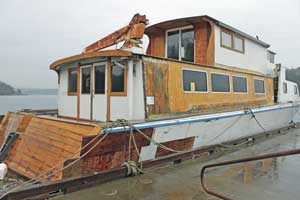Prevention of derelict vessels is becoming the new paradigm in dealing with sinking, abandoned or illegally moored boats in Washington.
Because identification and removal of derelict boats has been such a success in San Juan County, the Puget Sound Partnership in 2013 awarded the county more than $300,000 to develop and coordinate a derelict vessel prevention program in other Puget Sound counties.
The county was chosen to administer the money because it is the only county in the state, and perhaps the nation, to create a prevention program to identify vessels at risk before they become a hazard to navigation, a burden to taxpayers and a danger to the environment.
“The key word here is ‘prevention’,” said Friday Harbor’s Marc Forlenza, coordinator of both the county and state programs.
The counties that received funds to join the San Juan County-led prevention program are Jefferson, King, Kitsap, Mason, Pierce and Snohomish. Four other counties have expressed interest in joining the program, and, according to Forlenza, Grays Harbor County was represented at the first meeting and is expanding its prevention efforts as well.
The Department of Natural Resources has had a derelict vessel removal program in place for about a decade, but DNR salvage costs are very high, especially when a vessel has already sunk, as was evident when it cost the state almost $1.3 million to re-float and dispose of the 140-foot crabbing boat Deep Sea, which caught fire and sank two years ago Island County’s Penn Cove. Island County has opted not to participate in the Puget Sound prevention program.
Workshop For Prevention
The new program was inaugurated at a two-day workshop at the Padilla Bay Reserve, where a dozen representatives of interested counties gathered to learn how to set up and manage a derelict prevention program of their own. The PSP-sponsored workshop was conducted by Forlenza, derelict vessel specialist Joanruth Bauman, PSP Stewardship Coordinator Debbie Ruggles and two social marketing professionals.
“Prevention efforts are sometimes able to get owners to take responsibility for their vessels and solve the problem without further intervention from us,” Bauman told the group.
Bauman founded and managed the local program that has become the model for the statewide program. She estimates that San Juan County responded to 19 vessels that had either sank or were in trouble in 2012, costing taxpayers $76,586. After starting its prevention program in 2013, the county needed to remove only four vessels and dealt with 49 derelict vessels of concern at a total cost of $23,521 – less than one-third the 2012 expense.
“This program, once, implemented, will potentially save the state millions of dollars by avoiding costly salvage expenses due to vessel owner negligence,” Forlenza said. “It is a win-win for the taxpayers of Washington and our threatened marine environment. We want the program to be expanded statewide, and there may be national applications and national funding possibilities in the future.”
Washington state Sen. Kevin Ranker, D-Orcas Island, who has been active in the Legislature on the issue derelict vessels and prevention, hailed the statewide expansion of the San Juan County program.
“The derelict vessel prevention program is one of the more effective programs in Washington state,” Ranker said. “This program helps keep pollution out of our marine waters, removes visual eyesores from our beautiful vistas and saves hundreds of thousands taxpayer dollars by working proactively to prevent costly environmental disasters. Our citizens, economy, and environment will all benefit.”
Vessels at risk—what to look for:
—Boats that appear to be illegally moored and have not moved in more than 30 days.
—Boats that list to one side.Boats covered with unusual quantities of growth of algae, moss, grass or plant material.
—Boats with a bilge pump runs continually or frequently to expel water from the hull.
—Boats leaking fluids like oil, fuel, or waste.Boats with severe external deterioration of paint, wood, or other materials.
—Boat owners or live-aboards who throw waste or other materials into the water.Boat that drift from moorage or docks.
Questions about derelict boats? Contact Marc Forlenza (360) 472-1644 or DNR (360) 902-1574, or email dvrp@dnr.wa.gov.




